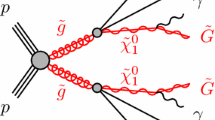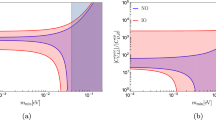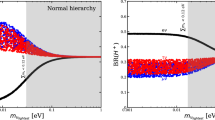Abstract
Though the 125-GeV scalar, as the Higgs boson of the standard model, is disfavoured as a dark matter portal by direct searches and the observations on relic density, a heavier scalar in an extended electroweak sector can fit into that role. We explore this possibility in the context of two Higgs doublet models (2HDM). Taking Type I and Type II 2HDM as illustration, and assuming a scalar gauge singlet dark matter particle, we show that the heavy neutral CP-even scalar (H) can (a) serve as dark matter portal consistently with all data, and (b) have a substantial invisible branching ratio, over a wide region of the parameter space. Using this fact, we estimate rates of LHC signals where H is produced via (i) gluon fusion, in association with a hard jet, and (ii) vector boson fusion. Invisible decays of the H can then lead to monojet + E/T in (i), and two forward jets with large rapidity gap + E/T in (ii). The second kind of signal usually yields better significance for the high-luminosity run. We also supplement our cut-based analyses with those based on gradient boosted decision trees (XGboost) and artificial neural network (ANN) techniques, where the statistical significance distinctly improves.
Article PDF
Similar content being viewed by others
Avoid common mistakes on your manuscript.
References
A. Djouadi, A. Falkowski, Y. Mambrini and J. Quevillon, Direct Detection of Higgs-Portal Dark Matter at the LHC, Eur. Phys. J.C 73 (2013) 2455 [arXiv:1205.3169] [INSPIRE].
H. Han, J.M. Yang, Y. Zhang and S. Zheng, Collider Signatures of Higgs-portal Scalar Dark Matter, Phys. Lett.B 756 (2016) 109 [arXiv:1601.06232] [INSPIRE].
L. Lopez-Honorez, T. Schwetz and J. Zupan, Higgs portal, fermionic dark matter and a Standard Model like Higgs at 125 GeV, Phys. Lett.B 716 (2012) 179 [arXiv:1203.2064] [INSPIRE].
A. Greljo, J. Julio, J.F. Kamenik, C. Smith and J. Zupan, Constraining Higgs mediated dark matter interactions, JHEP11 (2013) 190 [arXiv:1309.3561] [INSPIRE].
M.A. Fedderke, J.-Y. Chen, E.W. Kolb and L.-T. Wang, The Fermionic Dark Matter Higgs Portal: an effective field theory approach, JHEP08 (2014) 122 [arXiv:1404.2283] [INSPIRE].
Planck collaboration, Planck 2013 results. XVI. Cosmological parameters, Astron. Astrophys.571 (2014) A16 [arXiv:1303.5076] [INSPIRE].
J.F. Gunion, H.E. Haber, G.L. Kane and S. Dawson, The Higgs Hunter’s Guide, Front. Phys.80 (2000) 1 [INSPIRE].
G.C. Branco, P.M. Ferreira, L. Lavoura, M.N. Rebelo, M. Sher and J.P. Silva, Theory and phenomenology of two-Higgs-doublet models, Phys. Rept.516 (2012) 1 [arXiv:1106.0034] [INSPIRE].
L. Wang, R. Shi and X.-F. Han, Wrong sign Yukawa coupling of the 2HDM with a singlet scalar as dark matter confronted with dark matter and Higgs data, Phys. Rev.D 96 (2017) 115025 [arXiv:1708.06882] [INSPIRE].
P. Bandyopadhyay, E.J. Chun and R. Mandal, Scalar Dark Matter in Leptophilic Two-Higgs-Doublet Model, Phys. Lett.B 779 (2018) 201 [arXiv:1709.08581] [INSPIRE].
M.S. Boucenna and S. Profumo, Direct and Indirect Singlet Scalar Dark Matter Detection in the Lepton-Specific two-Higgs-doublet Model, Phys. Rev.D 84 (2011) 055011 [arXiv:1106.3368] [INSPIRE].
L. Wang, X.-F. Han and B. Zhu, Light scalar dark matter extension of the type-II two-Higgs-doublet model, Phys. Rev.D 98 (2018) 035024 [arXiv:1801.08317] [INSPIRE].
A. Arhrib, R. Benbrik, M. El Kacimi, L. Rahili and S. Semlali, Extended Higgs sector of 2HDM with real singlet facing LHC data, arXiv:1811.12431 [INSPIRE].
A. Berlin, S. Gori, T. Lin and L.-T. Wang, Pseudoscalar Portal Dark Matter, Phys. Rev.D 92 (2015) 015005 [arXiv:1502.06000] [INSPIRE].
G. Arcadi, A. Djouadi and M. Raidal, Dark Matter through the Higgs portal, arXiv:1903.03616 [INSPIRE].
A. Drozd, B. Grzadkowski, J.F. Gunion and Y. Jiang, Extending two-Higgs-doublet models by a singlet scalar field — the Case for Dark Matter, JHEP11 (2014) 105 [arXiv:1408.2106] [INSPIRE].
N.G. Deshpande and E. Ma, Pattern of Symmetry Breaking with Two Higgs Doublets, Phys. Rev.D 18 (1978) 2574 [INSPIRE].
S. Nie and M. Sher, Vacuum stability bounds in the two Higgs doublet model, Phys. Lett.B 449 (1999) 89 [hep-ph/9811234] [INSPIRE].
A. Arhrib, Unitarity constraints on scalar parameters of the standard and two Higgs doublets model, in Workshop on Noncommutative Geometry, Superstrings and Particle Physics Rabat, Morocco, June 16–17, 2000, 2000, hep-ph/0012353 [INSPIRE].
S. Kanemura, T. Kubota and E. Takasugi, Lee-Quigg-Thacker bounds for Higgs boson masses in a two doublet model, Phys. Lett.B 313 (1993) 155 [hep-ph/9303263] [INSPIRE].
B.W. Lee, C. Quigg and H.B. Thacker, The Strength of Weak Interactions at Very High-Energies and the Higgs Boson Mass, Phys. Rev. Lett.38 (1977) 883 [INSPIRE].
B.W. Lee, C. Quigg and H.B. Thacker, Weak Interactions at Very High-Energies: The Role of the Higgs Boson Mass, Phys. Rev.D 16 (1977) 1519 [INSPIRE].
I.F. Ginzburg and I.P. Ivanov, Tree-level unitarity constraints in the most general 2HDM, Phys. Rev.D 72 (2005) 115010 [hep-ph/0508020] [INSPIRE].
M.E. Peskin and T. Takeuchi, Estimation of oblique electroweak corrections, Phys. Rev.D 46 (1992) 381 [INSPIRE].
J. Erler and M. Schott, Electroweak Precision Tests of the Standard Model after the Discovery of the Higgs Boson, Prog. Part. Nucl. Phys.106 (2019) 68 [arXiv:1902.05142] [INSPIRE].
Muon g-2 collaboration, Final Report of the Muon E821 Anomalous Magnetic Moment Measurement at BNL, Phys. Rev.D 73 (2006) 072003 [hep-ex/0602035] [INSPIRE].
T. Aoyama, M. Hayakawa, T. Kinoshita and M. Nio, Complete Tenth-Order QED Contribution to the Muon g-2, Phys. Rev. Lett.109 (2012) 111808 [arXiv:1205.5370] [INSPIRE].
A. Czarnecki, W.J. Marciano and A. Vainshtein, Refinements in electroweak contributions to the muon anomalous magnetic moment, Phys. Rev.D 67 (2003) 073006 [Erratum ibid.D 73 (2006) 119901] [hep-ph/0212229] [INSPIRE].
A. Cherchiglia, D. Stöckinger and H. Stöckinger-Kim, Muon g-2 in the 2HDM: maximum results and detailed phenomenology, Phys. Rev.D 98 (2018) 035001 [arXiv:1711.11567] [INSPIRE].
M. Czakon, P. Fiedler, T. Huber, M. Misiak, T. Schutzmeier and M. Steinhauser, The((Q 7, Q 1,2) contribution to \( \overline{B} \) → X sγ at O \( {\alpha}_s^2 \)), JHEP04 (2015) 168 [arXiv:1503.01791] [INSPIRE].
M. Misiak et al., Estimate of B(\( \overline{B} \) → X sγ) at O(\( {\alpha}_s^2 \)), Phys. Rev. Lett.98 (2007) 022002 [hep-ph/0609232] [INSPIRE].
HFLAV collaboration, Averages of b-hadron, c-hadron and τ -lepton properties as of summer 2016, Eur. Phys. J.C 77 (2017) 895 [arXiv:1612.07233] [INSPIRE].
CMS and LHCb collaborations, Observation of the rare \( {B}_s^0 \) → μ +μ −decay from the combined analysis of CMS and LHCb data, Nature522 (2015) 68 [arXiv:1411.4413] [INSPIRE].
Belle collaboration, Evidence for B − → τ − \( {\overline{\nu}}_{\tau } \)with a Hadronic Tagging Method Using the Full Data Sample of Belle, Phys. Rev. Lett.110 (2013) 131801 [arXiv:1208.4678] [INSPIRE].
Belle collaboration, Measurement of the branching fraction of B + → τ +ν τdecays with the semileptonic tagging method, Phys. Rev.D 92 (2015) 051102 [arXiv:1503.05613] [INSPIRE].
ATLAS and CMS collaborations, Measurements of the Higgs boson production and decay rates and constraints on its couplings from a combined ATLAS and CMS analysis of the LHC pp collision data at \( \sqrt{s} \) = 7 and 8 TeV, JHEP08 (2016) 045 [arXiv:1606.02266] [INSPIRE].
CMS collaboration, Measurements of properties of the Higgs boson in the diphoton decay channel with the full 2016 data set, CMS-PAS-HIG-16-040 (2016).
CMS collaboration, C. Collaboration, Measurements of properties of the Higgs boson decaying into four leptons in pp collisions at \( \sqrt{s} \) = 13 TeV, CMS-HIG-16-041 (2016).
CMS collaboration, Higgs to WW measurements with 15.2 fb−1of 13 TeV proton-proton collisions, CMS-PAS-HIG-16-021 (2016).
CMS collaboration, Observation of the Higgs boson decay to a pair of τ leptons with the CMS detector, Phys. Lett.B 779 (2018) 283 [arXiv:1708.00373] [INSPIRE].
ATLAS collaboration, Measurements of Higgs boson properties in the diphoton decay channel with 36.1 fb −1pp collision data at the center-of-mass energy of 13 TeV with the ATLAS detector, ATLAS-CONF-2017-045 (2017).
ATLAS collaboration, Measurement of the Higgs boson coupling properties in the H →ZZ ∗ →4ℓ decay channel at \( \sqrt{s} \) = 13 TeV with the ATLAS detector, ATLAS-CONF-2017-043 (2017).
CMS collaboration, Search for invisible decays of a Higgs boson produced through vector boson fusion in proton-proton collisions at \( \sqrt{s} \) = 13 TeV, Phys. Lett.B 793 (2019) 520 [arXiv:1809.05937] [INSPIRE].
D. Chowdhury and O. Eberhardt, Update of Global Two-Higgs-Doublet Model Fits, JHEP05 (2018) 161 [arXiv:1711.02095] [INSPIRE].
XENON collaboration, Dark Matter Search Results from a One Ton-Year Exposure of XENON1T, Phys. Rev. Lett.121 (2018) 111302 [arXiv:1805.12562] [INSPIRE].
Fermi-LAT collaboration, Searching for Dark Matter Annihilation from Milky Way Dwarf Spheroidal Galaxies with Six Years of Fermi Large Area Telescope Data, Phys. Rev. Lett.115 (2015) 231301 [arXiv:1503.02641] [INSPIRE].
CMS collaboration, Searches for invisible decays of the Higgs boson in pp collisions at \( \sqrt{s} \) = 7, 8 and 13TeV, JHEP02(2017) 135 [arXiv:1610.09218] [INSPIRE].
ATLAS collaboration, Combination of searches for invisible Higgs boson decays with the ATLAS experiment, Phys. Rev. Lett.122 (2019) 231801 [arXiv:1904.05105] [INSPIRE].
J. Alwall et al., The automated computation of tree-level and next-to-leading order differential cross sections and their matching to parton shower simulations, JHEP07 (2014) 079 [arXiv:1405.0301] [INSPIRE].
T. Sjöstrand, S. Mrenna and P.Z. Skands, PYTHIA 6.4 Physics and Manual, JHEP05 (2006) 026 [hep-ph/0603175] [INSPIRE].
DELPHES 3 collaboration, DELPHES 3, A modular framework for fast simulation of a generic collider experiment, JHEP02 (2014) 057 [arXiv:1307.6346] [INSPIRE].
ATLAS collaboration, Combined measurements of Higgs boson production and decay using up to 80 fb −1of proton-proton collision data at \( \sqrt{s} \) = 13 TeV collected with the ATLAS experiment, ATLAS-CONF-2019-005 (2019).
N. Chakrabarty and B. Mukhopadhyaya, High-scale validity of a two Higgs doublet scenario: predicting collider signals, Phys. Rev.D 96 (2017) 035028 [arXiv:1702.08268] [INSPIRE].
ATLAS collaboration, Search for dark matter and other new phenomena in events with an energetic jet and large missing transverse momentum using the ATLAS detector, JHEP01 (2018) 126 [arXiv:1711.03301] [INSPIRE].
D.L. Rainwater, D. Zeppenfeld and K. Hagiwara, Searching for H → τ +τ −in weak boson fusion at the CERN LHC, Phys. Rev.D 59 (1998) 014037 [hep-ph/9808468] [INSPIRE].
V. Hankele, G. Klamke, D. Zeppenfeld and T. Figy, Anomalous Higgs boson couplings in vector boson fusion at the CERN LHC, Phys. Rev.D 74 (2006) 095001 [hep-ph/0609075] [INSPIRE].
A. Datta, P. Konar and B. Mukhopadhyaya, Invisible charginos and neutralinos from gauge boson fusion: A Way to explore anomaly mediation?, Phys. Rev. Lett.88 (2002) 181802 [hep-ph/0111012] [INSPIRE].
V.A. Khoze, A.D. Martin and M.G. Ryskin, Double-diffractive Higgs production and pomeron pomeron luminometry in proton collisions, Nucl. Phys. Proc. Suppl.B 99 (2001) 188.
V.A. Khoze, A.D. Martin and M.G. Ryskin, Soft diffraction at the LHC and properties of the Pomeron, Nucl. Phys. Proc. Suppl.B 99 (2001) 213 [hep-ph/0011319] [INSPIRE].
T. Chen and C. Guestrin, XGBoost: A Scalable Tree Boosting System, arXiv:1603.02754 [INSPIRE].
L. Teodorescu, Artificial neural networks in high-energy physics, in Inverted CERN School of Computing, CERN, Geneva Switzerland (2008).
P. Baldi, P. Sadowski and D. Whiteson, Searching for Exotic Particles in High-Energy Physics with Deep Learning, Nature Commun.5 (2014) 4308 [arXiv:1402.4735] [INSPIRE].
MicroBooNE collaboration, Automated Proton Track Identification in MicroBooNE Using Gradient Boosted Decision Trees, in Proceedings of Meeting of the APS Division of Particles and Fields (DPF 2017), Fermilab, Batavia U.S.A. (2017), http://lss.fnal.gov/archive/2017/conf/fermilab-conf-17-440-e.pdf [arXiv:1710.00898].
K.Y. Oyulmaz, A. Senol, H. Denizli and O. Cakir, Top quark anomalous FCNC production via tqg couplings at FCC-hh, Phys. Rev.D 99 (2019) 115023 [arXiv:1902.03037] [INSPIRE].
B. Bhattacherjee, S. Mukherjee and R. Sengupta, Discrimination between prompt and long-lived particles using convolutional neural network, arXiv:1904.04811 [INSPIRE].
K. Hultqvist, R. Jacobsson and K.E. Johansson, Using a neural network in the search for the Higgs boson, Nucl. Instrum. Meth.A 364 (1995) 193.
N. Bakhet, M. Yu. Khlopov and T. Hussein, Neural Networks Search for Charged Higgs Boson of Two Doublet Higgs Model at the Hadrons Colliders, arXiv:1507.06547 [INSPIRE].
R.D. Field, Y. Kanev, M. Tayebnejad and P.A. Griffin, Using neural networks to enhance the Higgs boson signal at hadron colliders, Phys. Rev.D 53 (1996) 2296 [INSPIRE].
J.R. Hermans, https://github.com/cerndb/dist-keras.
Open Access
This article is distributed under the terms of the Creative Commons Attribution License (CC-BY 4.0), which permits any use, distribution and reproduction in any medium, provided the original author(s) and source are credited
Author information
Authors and Affiliations
Corresponding author
Additional information
ArXiv ePrint: 1905.02242
Rights and permissions
Open Access This article is licensed under a Creative Commons Attribution 4.0 International License, which permits use, sharing, adaptation, distribution and reproduction in any medium or format, as long as you give appropriate credit to the original author(s) and the source, provide a link to the Creative Commons licence, and indicate if changes were made.
The images or other third party material in this article are included in the article’s Creative Commons licence, unless indicated otherwise in a credit line to the material. If material is not included in the article’s Creative Commons licence and your intended use is not permitted by statutory regulation or exceeds the permitted use, you will need to obtain permission directly from the copyright holder.
To view a copy of this licence, visit https://creativecommons.org/licenses/by/4.0/.
About this article
Cite this article
Dey, A., Lahiri, J. & Mukhopadhyaya, B. LHC signals of a heavy doublet Higgs as dark matter portal: cut-based approach and improvement with gradient boosting and neural networks. J. High Energ. Phys. 2019, 4 (2019). https://doi.org/10.1007/JHEP09(2019)004
Received:
Revised:
Accepted:
Published:
DOI: https://doi.org/10.1007/JHEP09(2019)004




